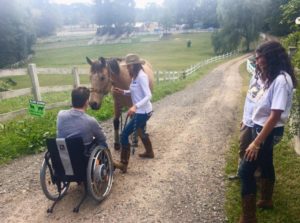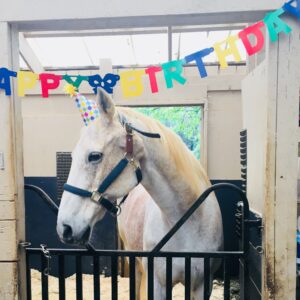By Nikki Alvin-Smith
Case Study: EAGALA Team Rene Stone and Her 29 Year Old Horse Tristan Help PTSD Sufferers
When Rene Stone was 30 she bought her first horse, the now 29 year-old Thoroughbred Tristan. While his body was broken, his spirit was bright and Rene Stone took a chance on him because she saw that light that shone within.
Their journey together has touched the lives of many war veterans and other sufferers of PTSD. As a licensed EAGALA (Equine Assisted Growth & Learning Association) therapist, Stone has battled some equine medical issues during the set up and success of her treatment program and her journey has had some severe ups and downs. Stone credits the fact that her dear horse Tristan is still up and at it working as an emotional support equine at her Serenity Stables From Combat to Calm, based in Atantic Crossing, NJ, in part to the knowledge and careful advice that Dr. John Byrd of Horsemen’s Laboratory and his innovative online testing and consultation service have provided this special partnership for over 15 years.
“ I believe that keeping this {John Byrd’s} testing and deworming protocol has given my horse the ability to handle the myriad of diseases and issues he has faced over the years, as it has helped keep his immune system intact,” stated Stone.

Indeed Tristan’s medical life has been no walk in the park. He is one of few horses that has actually survived Equine Protozoal Myelitis ( E.P.M.). He has also overcome colic, Lyme disease and suffers from a baseball-sized melanoma under his chin.
“ It’s amazing that Tristan survived the $3000 highly toxic Marquis treatment for E.P.M. I still wonder today if he would have made it if I had subjected his immune system to a barrage of dewormers up until then. Thank goodness I hadn’t.
When I purchased my first horse Tristan as a 3 year old I was 30. I knew very little about horses and their care so I marched along to the tune of the advice that I was given and treatments that were required, at the livery barn as to deworming and other care. When my horse started to have repeated colic episodes my vet suggested that fecal egg worm counts might be in order to evaluate whether equine parasites were the cause. He referred me to Horsemen’s Laboratory. I’ve been working with Dr. Byrd ever since,” said Stone.
Stone quickly moved away from the blind rotational deworming practices that were in place during the 1990’s. Tristan F.E.C.T. results showcased he was a high shedder of worm eggs, with readings up to 1200+ strongyle eggs and the current program she was following of 6-8 week deworming was not working.
“At this point we can keep the strongyle shedding egg count numbers down for approximately 3 months at a time. I test and then treat with Ivermectin or Equimax, and then retest 2 ½ weeks later, to see if we have an encysted worm population that has shed out. If it has, I administer another treatment. Tristan is a special case, most of my other horses are consistently negative on their egg count tests. I do pick the pastures to manage contamination,” explained Stone.
We asked Dr. John Byrd for his recommendations for horses that are high shedders such as Tristan. Dr. Byrd explained that while his protocols may not be the same as all other vets might recommend, his treatment regime is based on the knowledge that has resulted from his experience testing over 75,000 F.E.C.T’s at Horsemen’s Laboratory and his specialist insight into equine parasitology treatment over decades.
The most up to date research supports F.E.C.T. as a cornerstone of a targeted equine worm control program, and it is recommended by the A.A.E.P. Dr. Byrd’s specialist knowledge in this arena make him a keen resource for the horse owner, and he is a sought after clinician at events nationwide as an educator on the topic (please don’t hesitate to contact Dr. Byrd for rates and availability if you would like to book him for a lecture).
“My first recommendation for high shedders is generally Quest (moxidectin) for horses that are in good condition because it is the best at killing the encysted larvae. If the egg count is over 1500-2000 eggs and the horse’s history indicates they are consistently high I may suggest that they deworm it again in 4-6 weeks with a dose of Ivermectin. For miniature, very young, or very thin horses I would recommend 2 doses of Ivermectin 4-6 weeks apart. Some owners are concerned about what they have read on the internet about moxidectin so, for them I would recommend the 2 doses of Ivermectin 4 weeks a part. My reason for giving the Ivermectin twice is that the first dose will likely kill all the adult strongyles that are laying eggs. A second egg count 2-3 weeks after the first dose of Ivermectin should be done to prove it was effective. The second dose 4-6 weeks later should kill all of the larvae and adults that have left the cysts and developed into young adults since the first deworming and before they start laying eggs.”
When asked if high shedders should be separated in pastures from medium or low worm egg shedders, or whether diligent manure pick up of pastures is enough to protect the lesser shedders, Dr. Byrd shared his opinion:
“ This is a very good question and not easily answered. I believe it somewhat depends how big of a herd the owner has and the size and number of pastures an owner has. As far as separating the herd according to shedding category they fall in I believe it is good in a herd of over 15-20 horses to use shedding rate as one criteria. However other factors must be also considered such as how do they get along, how old they are, and sex, these factor may over ride the shedding rate as to how the herd is divided.
No matter the size of the herd, diligent manure pick up will generally reduce exposure to infective stage larvae for all horses in the pasture because it removes the larvae from the pasture before they reach the infective stage. I am often asked how often should I pick up the manure in my pasture? The length of time it takes the strongyle larvae to reach the infective stage after the eggs are passed in the stool is quite variable, depending on the available oxygen, moisture and temperature. I believe the ideal temperature is 65-80 degrees F and if there is adequate oxygen and moisture the infective larvae can hatch and develop into the infective stage in as little as 24-48 hours. So, these environmental factors will determine how often the manure should be picked up. Therefore, I generally recommend 2-3 times a week when the conditions are ideal for egg hatching and larval development. Remember most of the time you will only have to pick up the manure piles in the rough areas of the pasture because that is where the majority of the manure is passed. Remember that the thought is, 20% of the horses in a pasture are responsible for 80% of the infective larvae in the pasture. F.E.C.T’s will identify the 20% of the horses that are responsible for the 80% of the contamination and then you will only have to deworm these high shedders to greatly reduce the exposure rate for all the horses in the pasture.”
The topic of targeted deworm control is very much in the media today. The foresight that horse owners such as Rene Stone showcased in taking prompt remedial action when her horse showed colic issues to address her horse Tristan’s individual needs is no doubt responsible for his longevity. In addition to following an evidence based deworming control program and picking manure from fields at her farm, Stone also uses probiotics and organic hay to help support all her horses’ wellbeing.
Stone’s Serenity Stables provides an important resource for all folks suffering from PTSD. While the majority of the folks that benefit from work with Serenity Stables horses and personnel help are war veterans, there are many other PTSD sufferers that gain healing from being around horses.

“ Recently Tristan celebrated his 29thbirthday, and the gals that through the party were victims of sex trafficking and rape. It is wonderful to see how horses have helped these young women overcome their awful experiences,” shared Stone.
While you’re here why not sign up to help this wonderful 501c 3 charity, with a small donation? There are always fundraising events going on at Serenity Stables, and donations of any size are always appreciated. Please visit https://www.serenitystablesfcc.org/donate/ to help out and visit their websiteto learn more about EAGALA benefits that make the world of difference in reducing suicide rates and improve the quality of life for P.T.S.D. sufferers.



